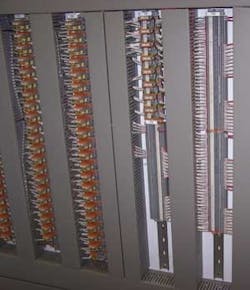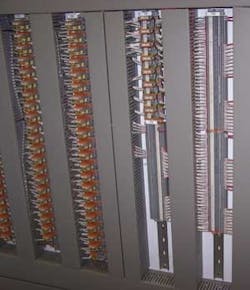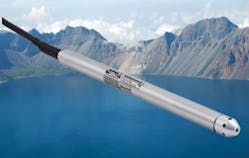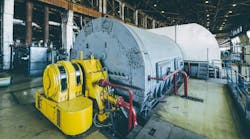By Paul Garcia
Roseville, CA, provides wastewater treatment services to 130,000 Californian in a region northeast of Sacramento. To protect a local stream, one of its plants uses cooling towers to cool water before it is discharged to the creek. During construction of the towers, special spring terminal blocks were used in wiring the automation systems.
Roseville's $100 million Pleasant Grove Wastewater Treatment Facility performs screening, extended aeration, secondary clarification, filtering, disinfection and dispersal of seven million gallons of wastewater daily. The fully automated, five-year-old facility operates in tandem with Roseville's other wastewater facility, Dry Creek, to process 19 mgd for 130,000 Californians.
This control panel at the Dry Creek facility uses WAGO Spring Pressure Terminal blocks. Rather than rely on screws, installers simply push conductors in. Photos courtesy of Charles Aycock, City of Roseville.
"Roseville assists with sprawling regional treatment," said Charles Aycock, EIM Systems Coordinator for the City of Roseville. "Our regional partners rely on us for some portion of their wastewater treatment."
Roseville, 16 miles northeast of Sacramento, was America's sixth-fastest growing city in 2008 according to the U.S. Census Bureau. Moreover, with an estimated 112,660 residents, it has also been one of California's top-10 fastest-growing cities for two consecutive years. Commerce has also expanded, with heavy-hitters such as Hewlett-Packard and NEC Technologies establishing operations in Roseville.
This makes wastewater treatment no small task for the burgeoning metropolis, particularly in the face of California's ongoing drought. Pleasant Grove is operating at 58% of its 12 mgd capacity; Dry Creek, with an 18 mgd max capacity, is running at 61% capacity.
Roseville recycles approximately 35% of wastewater to irrigate major golf courses, select greenscapes and cool its powerplant. Drive past Roseville's manicured greenways, and it's evident wastewater recycling is a major component of sustainability – street medians bear lavender-colored signs reading "Irrigated with Recycled Water."
Cooling Towers
Roseville pre-empted upcoming legislation by including wastewater cooling towers at its Dry Creek facility. After secondary treatment, a fan aerates trickling effluent within the tower. The effluent is then dechlorinated for irrigation, powerplant cooling or discharge into Dry Creek – the plant's namesake. Although effluent cooling is becoming increasingly common, it was't in 2003–2004.
Cooled effluent must be within five degrees of the Dry Creek's temperature to protect local flora and fauna. Dry Creek features several recreational areas along its 15-mile path and is a tributary to California's American River.
"During development, we proactively installed water temperature monitoring. There's lots of biological activity in the creek, and we need to ensure discharged effluent is within five degrees of the creek's temperature to avoid shocking flora and fauna. We were out to make sure we did't adversely affect any species," Aycock said.
With environmental stewardship and fiscal responsibility front-and-center, Roseville's team of maintenance techs and electricians targeted the terminal blocks used for electrical connections in the cooling tower. Their reasoning: a control system is only as reliable as the terminal blocks connecting it all.
"When you lose an input – say a digital one, or in a worst-case scenario, analog signals from process instrumentation – it inhibits the system," Aycock stated. "With automation, the whole goal was raising productivity and reliability."
In the tower's motor control center, an air-conditioned electrical room houses all power equipment. Typically, sensors, motors and PLCs would be interconnected via traditional, screw-style terminal blocks. However, staff decided screw-style terminal blocks would not provide the reliability or efficiency the plant needed.
"We chose the Spring Pressure Cage Clamp® for the PLC cabinets because of wires not being properly captured with screw-type terminal blocks." Aycock said. "We have a very high degree of confidence the wire is in the block correctly with Spring Pressure Technology and that the contact is good."
Similar to an evaporative cooler, giant fans cool trickling effluent at Roseville's Dry Creek Facility. Established in 2003–2004, the effluent cooling is a major component of the city's ecological protection and sustainability efforts.
Pioneered by WAGO in 1977, Cage Clamp® Spring Pressure Technology essentially "surrounds" conductors on all sides by a clamp that administers proportional clamping forces (greater force for larger conductors, less for smaller ones). This embeds conductors in the current bar's tin-plating for gas-tight seating. Dynamic contact automatically compensates for the expansion/contraction of metal with both ambient and current-induced temperature changes. This adjusts for settling strands and temperature cycling, allowing the spring cage to provide consistent termination force. This promised Roseville efficiency by eliminating screws, specialty tools or training for install and maintenance.
And, in a facility teeming with connections, ease and proper install are vital, as external personnel assist with install.
"Contractors do not always use proper torquing devices – they just grab a screwdriver and tighten. In older terminal blocks, the wires would often fall under backplates," Aycock said. "So, you would be screwing the unit to tighten, but the wire would't be between the contact points. The wire eventually falls out and you lose that signal. Those types of blocks can be deceptive."
Aycock reported since Pleasant Grove's opening, they have not experienced a single connection-related failure. This has freed the maintenance staff to focus on the one challenge posed by automation: brain drain.
"We've found a challenge in getting people here to maintain the automated system. Maintenance and install are two different skill sets, taking a different skill set to maintain higher-level systems," Aycock said. "Most of Roseville's techs are 45 years or older, so we're being proactive there too with an apprentice program," he added. WW
About the Author:
Paul Garcia is the Creative/Technical Writer for WAGO Corporation in Germantown, WI. He may be reached at [email protected].
More WaterWorld Current Issue Articles
More WaterWorld Archives Issue Articles




